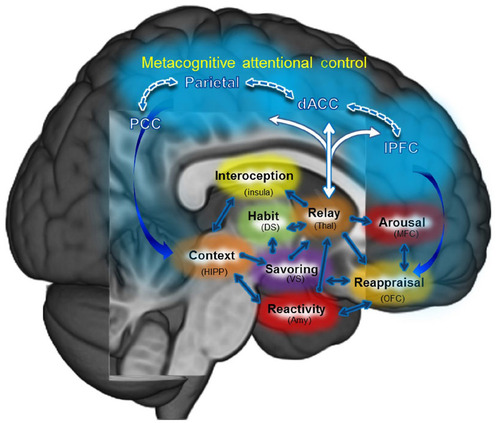Figures & data
Figure 1 Mindfulness-centered regulatory network.
Notes: The central tenet of this model posits that mindfulness-based interventions may remediate dysregulation in neural circuits integral to addiction by way of strengthening functional connectivity: 1) within a metacognitive attentional control network (dlPFC, dACC, parietal cortex); and 2) between the metacognitive attentional control network and brain regions subserving automatic habit behavior, memory consolidation, interoceptive awareness, and reward processing. Reproduced from Garland EL, Froeliger B, Howard MO. Mindfulness training targets neurocognitive mechanisms of addiction at the attention-appraisal-emotion interface. Front Psychiatry. 2013;4:173.Citation5
Abbreviations: dlPFC, dorsolateral prefrontal cortex; dACC, dorsal anterior cingulate cortex; PCC, posterior cingulate cortex; DS, dorsal striatum; VS, ventral striatum; Thal, thalamus; HIPP, hippocampus; Amy, amygdala; OFC, orbitofrontal cortex; MFC, medial prefrontal cortex; lPFC, lateral prefrontal cortex.
Abbreviations: dlPFC, dorsolateral prefrontal cortex; dACC, dorsal anterior cingulate cortex; PCC, posterior cingulate cortex; DS, dorsal striatum; VS, ventral striatum; Thal, thalamus; HIPP, hippocampus; Amy, amygdala; OFC, orbitofrontal cortex; MFC, medial prefrontal cortex; lPFC, lateral prefrontal cortex.

